Affiliate disclosure: This post may contain affiliate links. Please see our Privacy Policy.
The cost of a chicken can vary slightly by breed or depending on where you live, but for the most part, it’s reasonably predictable. Learn how much it costs to raise chickens at home, either egg-laying chickens or meat birds, as well as other backyard poultry such as ducks, turkeys, and more.
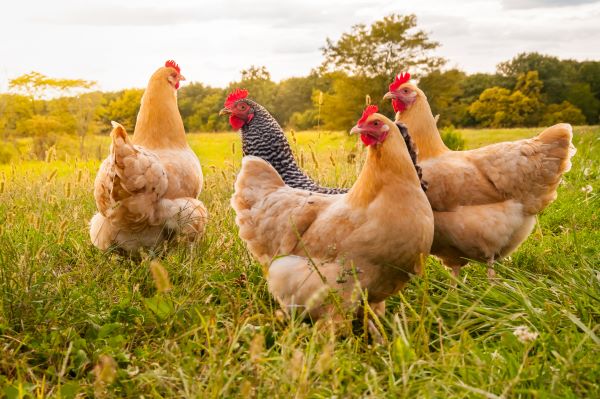
They call chickens a “gateway animal” and it’s true that they are a wonderful starter animal for beginner homesteaders. Readily available, easy to tend, and generally friendly, raising chickens can be incredibly rewarding.
While farm-fresh eggs are always tastier than storebought, does raising chickens actually make financial sense?
Whether you’re raising chickens for eggs or meat, this quick cost breakdown will take you through the economics of backyard chickens.
The following is reprinted with permission from The Beginner’s Guide to Backyard Homesteading, by Lisa Lombardo of the Self Sufficient Home Acre. It has been adapted slightly to fit an internet format.
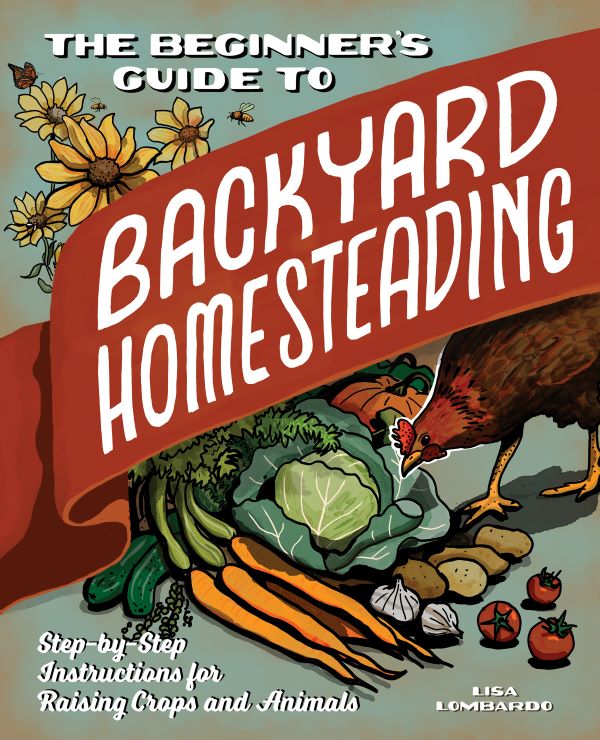
How Much Does it Cost to Raise Chickens?
What better way to get back to basics than gathering eggs? Chickens are often the first livestock that backyard homesteaders consider raising, and for good reason. Keeping a small flock of chickens is a wonderful way to increase your self-reliance and maybe even earn a side income.
If you want to save money, get eggs and meat from your homestead, or keep poultry for the small farm experience, start by researching the costs involved, time required, and best practices.
Raising Chickens Cost Breakdown
To assess your poultry project, you’ll need to determine the up-front investment and time required to care for your birds. There are many variables to consider, including how many you can accommodate in your space, whether you’re raising them for eggs or meat, and the cost of feed and materials such as feeders and coops.
Start by determining whether it’s cheaper for you to raise poultry yourself or purchase eggs and meat from a local grocer.
Let’s consider how much it might cost to raise farm-fresh eggs compared with purchasing them. The most productive hens can lay between 280 and 300 eggs per year. That means 25 layers could produce 7,000 to 7,500 eggs annually, or 583 to 625 dozen eggs.
By combining the cost to raise 25 chicks to point of lay and the cost to feed 25 hens per year (calculated later in this chapter), we can estimate the investment for 25 chickens for the first 17.5 months, about the time of their first molt, when they take a break from production. For that time frame, it would cost $840.10 to $2,218.35 for their basic care.
That means if they lay 625 dozen eggs, it would cost between$1.34 and $3.55 to produce each dozen.
According to the egg industry, the average cost of a dozen eggs in the United States at the time of this writing was $2.73, which means a potential savings of $1.39, or a loss of $0.82, per dozen eggs.
If your family uses two dozen eggs per week, you could save $139.36 each year if you keep expenses to a minimum. But based on these estimates, you could also potentially lose $85.28 when raising heavy breed hens on expensive feed.
How much you save depends on many factors, from the cost of chicks, feed, bedding, and a coop to the electricity required to power a brooder and keep a light on in winter. Here are some creative ways to reduce expenses:
- Raise grains and produce to supplement the chicken feed.
- Raise the chickens on pasture or feed them with weeds and kitchen scraps.
- Raise light breeds or hybrids for best production and feed consumption.
- Sell extra eggs, chicks, hatching eggs, or point of lay pullets.
- Process old laying hens for stewing to reduce expenses.
- Keep only productive hens and a rooster (if you want fertile eggs).
Whether you raise poultry for meat or eggs, you’ll need to plan. It takes four and a half to five and a half months to raise pullets (young female chickens) to point of lay or the age when they should begin to produce eggs. Broiler chickens and meat ducks take about eight weeks, and broad-breasted turkeys need about five months to reach butcher weight.
The trick is determining whether you have the budget and time to raise poultry successfully. Compare the expected cost of materials with your local prices or the current cost of products online, and figure out what your budget allows. Beyond just financial costs, be sure to read through the seasonal chores checklist (later in this article) to determine the approximate time commitment for this project.
Expected Cost of Materials for Raising Chickens
As you research the feasibility of this homestead project, be sure to take into account the cost of purchasing and caring for poultry. Using this section’s cost tables and your own research, list all the materials you need to set up and maintain the project for the first year. Include the cost of the first chicks, feed, bedding, coop, and other equipment.
Many people choose to start their poultry journey by investing in chicks. This list outlines the average cost of day-old birds.
Cost of Day-Old Poultry:
- Chickens: $1.50 to $6
- Ducks: $4 to $10
- Geese: $12 to $30
- Turkeys: $5.25 to $13
- Guinea fowl: $4 to $8
- Quail: $2.50 to $4
Based on price ranges from a variety of online hatchery catalogs in March 2020.
Keep in mind that until they are ready to go into their coop, chicks need a protected box or brooder, which should be part of your cost considerations. A large plastic storage tub may suffice for a few chicks, or you can build a brooder box to house them.
The brooder should be big enough to provide the chicks ample room to move about and find the most comfortable temperature. To ensure a healthy start, you’ll also need to provide chick starter feed, chick grit, clean water, and probiotics.
Cost of 50 Pounds of Poultry Feed (cost per pound):
- Chicken layer: $12 to $32 ($0.24 to $0.64)
- Chick starter: $13.50 to $30 ($0.27 to $0.60)
- Chicken meat producer: $14 to $28 ($0.28 to $0.56)
- Game bird: $16 to $27 ($0.32 to $0.54)
- Oyster shell (layer supplement): $12 to $33 ($0.24 to $0.66)
(Based on typical prices found in feed stores and online in March 2020.)
Use the following table to estimate feed costs and get a sense of how much it costs to feed one adult laying hen per day.

Cost of Feeding Laying Hens in Full Production in 2020
If you plan to feed a flock of 25 laying hens, expect to spend $1.50 to $4.75 each day, or $547.50 to $1,733.75 per year, assuming a price of $12.50 per 50 pounds of layer feed.
Unless you purchase point-of-lay pullets, you’ll also need to calculate the cost of raising chicks until they begin producing. The following table breaks down the cost of raising 25 chicks, assuming average prices for chicks and basic supplies.
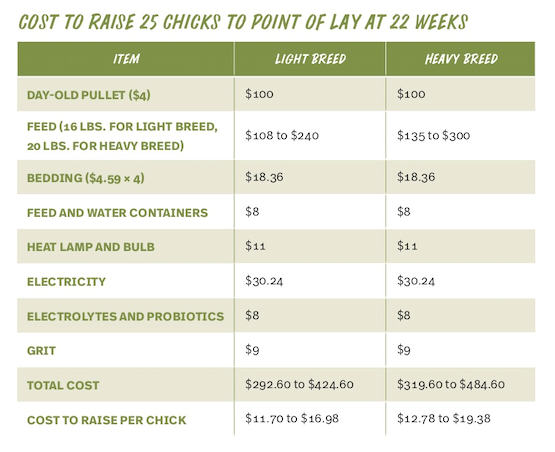
Based on typical prices found online in March 2020 and an average electricity price of $0.12 per hour for six weeks.
You may use some items for years, such as the feed dishes and heat lamp, but there are other expenditures to consider.
Other Poultry Costs:
- Chicken coop (homemade or purchased): $50 to $1,000
- Fencing (50-foot roll): $29 to $130
- Fence posts: $3.29 to $5
- Waterer: $6 to $35
- Feeder: $6 to $30
- Water heater for winter: $30 to $60
- Nest box: $13 to $20
- Pine shavings (8.25 cubic feet): $4.59 to $9
- Straw: $5+ per bale
- Vitamins and probiotics: $12 to $20 per 2 pounds \
- Egg cartons: $0.39 to $0.54 each
- Grit: $8 to $9 per 25 pounds
- Oyster shell: $12 to $15 per 50 pounds
(Based on typical prices found online in March 2020.)
There are various ways to reduce the cost of supplies. With some basic tools, you can build your coop, roosting bars, and nest boxes from scrap lumber or retrofit a garden shed or small barn.
Next, let’s look at the cost of consumable items needed to care for a flock of 25 hens for one year. Your hens will consume between 2,190 and 2,737.5 pounds of feed for a cost of $547.50 to $1,733.75. They’ll also need about 50 pounds of grit at $16 to $18, and up to 100 pounds of oyster shell for $24 to $30. You’ll need to provide 12 to 24 bales of straw bedding at $60 to $120. The basic cost total is $647.50 to $1,901.75 to keep 25 laying hens each year.
To calculate the cost for each hen, divide the total costs by 25 for an estimate of $25.90 to $76.07 per bird. You can use this calculation to estimate consumables costs for any size flock.
To calculate one-time expenses in your cost analysis, total them up and divide the cost by the life expectancy of the materials. Add these expenses to your egg and meat production costs.
Note that all poultry take a break from laying each year to molt (grow new feathers to replace the old ones). You can expect the first molt at about 18 months of age.
In addition, a hen will lay fewer eggs every year. It isn’t economical to keep old laying hens after two or three years. If you aren’t prepared to process them as stewing hens, your egg cost will increase.
If you want to gather eggs during winter, put a bright LED light on a timer in the coop. Set it to come on early in the morning and stay on for 14 to 15 hours a day.
This will trick your chickens into thinking it’s still summer. Ducks will often continue to lay during winter without a light.
There are additional considerations if you’re raising poultry for meat production. Broiler chickens don’t need as much space as laying hens, but ducks, geese, and turkeys all require more room.
You’ll need to process your meat birds at home or take them to a certified processing plant. Look for a local facility and ask about prices before you get started. Note that it is much more cost-effective to process your own birds.
The most popular broilers are Cornish hybrids because they gain weight rapidly and are ready to process at about eight weeks of age. Provide a minimum of 2 to 3 square feet of space in their coop (or more, if possible).
Broad-breasted turkeys and White Pekin ducks are also great for raising your own meat. The following table lists the costs of feeding meat birds, using the average cost for each expenditure shared in the lists Cost of 50 Pounds of Poultry Feed (previous table) and Cost of Day-Old Poultry (previous table). Your total costs could look very different depending on waste, cost of baby poultry, feed, and other variables.
Average Cost to Feed Meat Birds to Butcher Weight
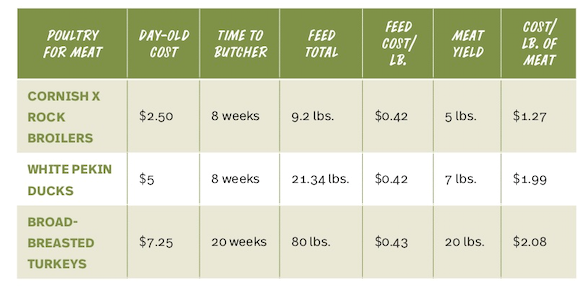
Estimated Time for Raising Chickens
Use the following seasonal chores checklist to estimate the time commitment for your poultry projects. You’ll need to provide care for your flock every day and find a farm sitter if you travel.
There are also seasonal chores, and you’ll have to raise replacement layers. Expect to spend about an hour each day feeding, watering, gathering eggs, mucking out the coop, letting the birds out in the morning, and putting them away at night.
Seasonal Chores for Poultry Care

Potential Problems Raising Chickens and Cost of Solutions
Research any problems you might encounter when raising poultry and the cost of potential solutions. Predators, illness, and pests are common issues. Consider talking to your Cooperative Extension Service office or consulting local farmers to identify particular threats in your area.
For example, poultry is often lost to predators such as hawks, coyotes, and even dogs. Intestinal parasites, mites, Marek’s disease, chronic respiratory disease, and sour crop are also common problems for laying hens. You can reduce parasites by rotating pastures and having chicks vaccinated at the hatchery.
Is Your Poultry Project Feasible This Year?
After estimating the cost and time commitment for your poultry project as well as reviewing potential problems, is the project feasible in your first season of homesteading? If you feel that your project will take more time or a larger budget than you have available, can you break it down into smaller steps or spread it out over several years?
Creating Goals for Poultry Action Plan
If raising poultry is a feasible project for your homestead, it’s time to set your goals. Make sure they align with your overall homestead goals. What do you want to accomplish during the first season?
Do you want to keep a few laying hens to supply eggs so you can be more self-reliant? Are you planning to sell eggs at a farmers’ market? Or are you hoping to raise chickens, turkeys, or ducks to fill your freezer for winter?
Excerpt from The Beginner’s Guide to Backyard Homesteading, by Lisa Lombardo, published by Rockridge Press. Copyright © 2020 by Callisto Media, Inc. All rights reserved.
Is Raising Chickens Worth the Cost?
The cost of raising chickens is substantial, and may not actually save you money over storebought eggs and meat. The thing is, you’re raising more than just your own food. You’ll know how those animals were treated, and you’ll be able to taste the difference with a truly fresh egg.
More recently, supply chain issues have further heightened the importance of raising at least some of your own food. In the spring of 2020 eggs were nearly impossible to buy in the store, but we pulled a basket of farm fresh eggs from our coop every morning.
Peace of mind is worth something, even if raising backyard chickens won’t fatten your bank account.
Homestead Cost Breakdowns
Looking for more homestead cost breakdowns?
- How Much Does it Cost to Raise a Pig?
- Can Small Scale Maple Farming Be Profitable?
- Starting a Backyard Raspberry Pick Your Own Operation
- 12 Ways to Make $1000 a Month from Your Garden
- How to Make a Full-Time Income Living Off the Grid
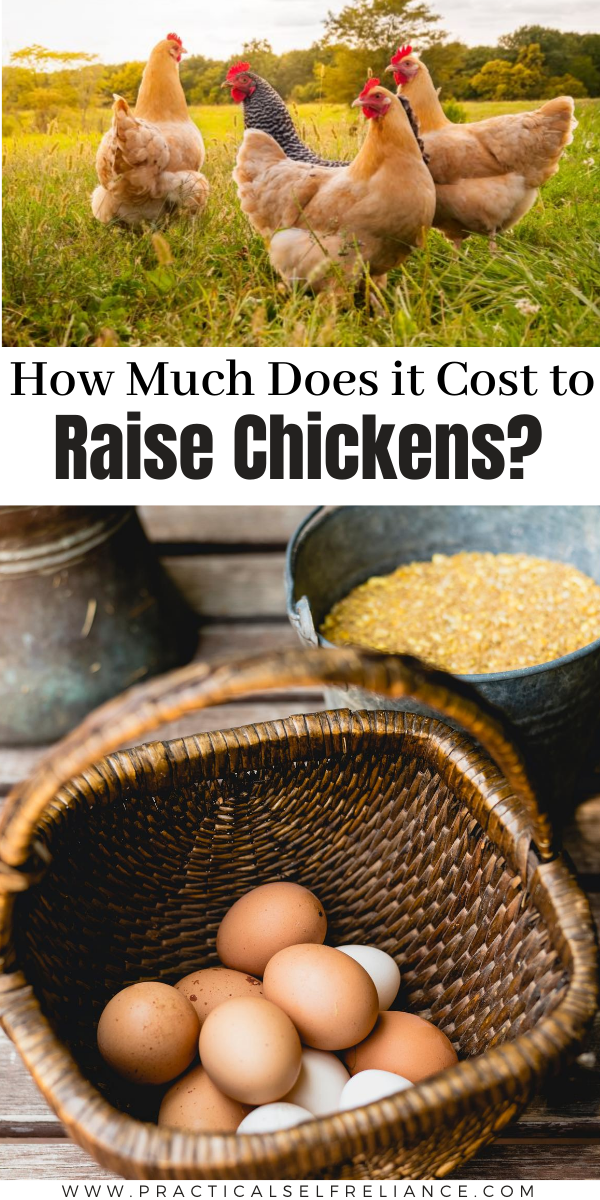

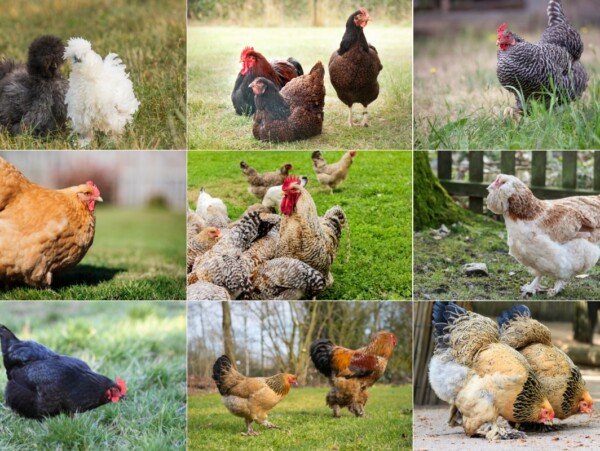
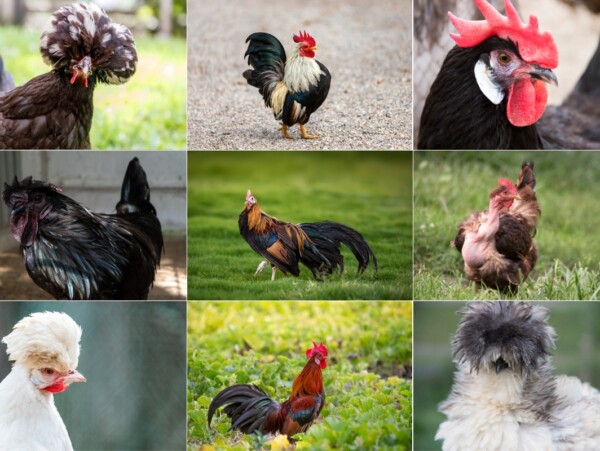
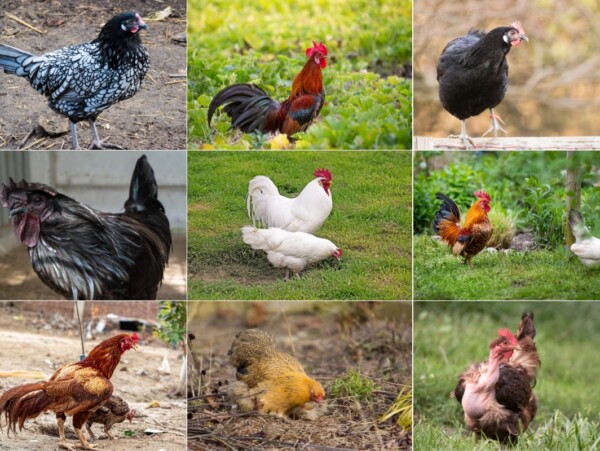
Do you know how we can feed chickens if we can’t get feed? I’m sure the pioneer’s didn’t just jump in the wagon and head to the feed store in the middle of winter. lol I don’t have enough space to grow grain. Any advice is much appreciated, thank you.
Do you have areas for the chickens to free range? They can get much of the nutrition they need from free ranging. You would need to store up some food supplies for the winter of course. You can also feed them scraps and grow extra veggies for them in the garden. Winter squash are a really great source of food as well.
“the average cost of a dozen eggs in the United States at the time of this writing was $2.73,”
That figure MAY be right, but here in Oregon, ORGANIC or PASTURE RAISED are between $6-$9 a dozen, making raising your own pasture/organically raised eggs a much better solution. I didn’t check the cost of the supplies to feed, but I’m certain they are also a bit more $$$.
To make this article more correct, you should have mentioned WHERE you live, as everywhere is different in costs of material/supplies/foods, etc.
Good point. This is a book excerpt, and I’m honestly not sure where the author lives. Here in VT, regular (not organic) eggs are around $5 to 6 a dozen now, but they were closer to $3 just a few years ago (organic is similarly priced to yours). I think prices have gone up dramatically on eggs and a lot of other stuff in the past few years, and inflation is a big part of this too.
Though that said, in many parts of the country you can still get a dozen for under $2. Pretty subjective by location, as is the price of grain. Great points you make, thanks!
As someone who hopes to raise chickens one day, this information is extremely helpful for knowing what costs we will be looking at. I like that you included not only the basic costs, like food and bedding, but all of the other costs that you likely will encounter.
Thank you. I’m so glad you found it helpful!
Ashley,
I am a grain grower in NW Ohio. My younger brother farms for our elder brother and me. He has four decades of experience. We started farming as babies riding the tractor. The ground was past to my brothers and me after Dad went to be with Mom in heaven.
Dad believed GMO’s were bad for the environment, wildlife, and people, so he grew non-GMO soybeans. He was good friends with the Maumee Water Shed director who has since retired. Dad talked about conservation and placed the back of the homestead into the Wildlife Wetlands Reserve Program. The ground wasn’t worth farming, but it surely made for a nice wildlife home for the animals running from neighboring chemicals.
Although Dad farmed with chemicals that I’d rather not think about, he used as little as possible to keep the weeds from overtaking the crop. He practiced conservative tillage; however, he preferred tilling the soil over using an extra round of chemical. Surely this practice delayed his plant dates, but I think he may have made this choice in respect for the environment.
My brothers and I wish to continue in Dad’s steps with non-GMO. That is not so difficult to do since my farmer cannot stomach GMO. My brother said how his friends were loosing their horses to GMO feed and to glyphosate sprayed oats. Loosing horses is a sizable impact to those who depend on an animal for transportation and for pulling farm implements. Oats are one of those crops that might be hosed 2 days before harvest with glyphosate as a means for an even crop kill to combine sooner.
Anyway, I think Dad would be pleased to know how his children farm non-GMO. I’d like to think when able to find a non-GMO premium for the bean that farming paid the bills, but the commodities market isn’t much different than decades ago when my brothers and I were babies.
Agriculture chemicals are harming the environment, wildlife, and people. So, step by step, I am working with my brother to turn Dad’s ground into organic production. In 2017 Dad’s first field was rolled into the organic program. This year, I hope to have the second field organic. We will see how things go, but I wish to begin the transition process in 2021 for my third and final field. From there, I’d like to think about helping my brothers in transitioning their ground.
I am struggling. The weather is harsher than when I was a child. The spring is wet, raining about every 4th day. Some years it is the second week of June before it is dry enough to work ground. The summer is crispy with little rainfall. My soybeans plants were stunted from the lack of rain. The fall is variable. Last weekend a light frost kissed my beans and the leaves stared to turn. The last two winters killed my rye with the Jan/Feb/Mar freeze/thaw cycles.
Between the unfavorable commodities market and the extreme weather, managing the ground is SUPER challenging. Somehow, I wish to progress, but I need to be able to pay for farm inputs and for my son and my medical bills in order to keep the family farm. If I sell my acreage to pay the medical bills, the ground will likely go into hands that take little thought toward the environment, wildlife, nor people. We are the non-GMO operation in the county, and we are one of two farmers in the county growing organic. I can see why for many reasons including the fact that the organic grain elevators take only corn, soy, and little wheat. My brother depends on these fields for a paycheck, and if I sell, I’d be taking from my brother’s ability to provide for his family. So, before I am up against a brick wall with no other choice but to sell, I am brainstorming. I am trying to think of ways to make the farm profitable.
The other day and into the night, I looked online for organic chicken scratch. It was painful to see the mark up. So, I looked online for bulk 50 lb. bags of oats, barley, and other grains. I can’t do it. I saw a 50 lb. bag of organic oats for $100. A couple of weeks ago, on an organic grain growers call, one of the farmers said how he received $6.50/bu. for his organic oats. He wouldn’t be able to keep his farm if all he grew were oats at that low of a price. In 2016, my transitional oats brought about $4.50/bu. I felt bad for my brother, because I don’t think the oats were enough to cover his equipment upkeep, fuel, and other farming costs for that field.
As an organic farmer, I need to rotate. The ground is marginal, but it grows soybeans. The corn grown in 2015 wasn’t worth my brother purchasing a corn header for the combine. So, I am looking at which crops I might be able to grow without the high, high input costs of corn and which crops might grow well on heavy clay soil. My brother is set up for grain row crops.
So, I’d like to look at growing a variety of small grains, grains that might be nice for chicken scratch. My chickens always go for the protein over the carbs. So, I’d like look at some high protein cultivars. My preference is by far for the heirloom varieties. I think there may be benefits not fully understood with the heirlooms. For instance, those who have gluten intolerance and cannot eat regular wheat may be able to consume heirloom wheat with its much, much lesser gluten content. Yes, wheat is bred to take a better stand, and the heirloom is usually taller and a bit more challenging to grow, but I’d like to offer nutrition. What might you suggest in the line of high protein, heirloom chicken scratch grains? Any other thoughts?
Kind regards
Amber
Hi Amber,
Honestly, I’d have to say it sounds like you’re definitely the expert here, with a lot more experience in the grain world than I have. I don’t have any constructive suggestions, other than I really hope you can find a way to keep the farm in production in a way that works both to pay the bills and to keep the land in clean production that favors the environment as much as is possible. It sounds like you’re doing everything in your power to achieve that, and I really hope it works out.
Ashley,
Thank you for the reply.
The local library has some books on crop rotation and on building soils that I was able to reserve. Hopefully, these books will help in managing the farm. Planting a cover crop mixture adds microbes to the soil and helps the soil in percolating water. Building the soil, from what knowledgeable farmers say, may be my farm’s answer in production.
The 15 chickens are laying eggs. My boy and I were outside this afternoon enjoying them. New Hampshire reds make nice pets. Their diet is somewhat varied as I test their preferences. Websites, like yours, provide a wealth of information on how to raise chickens. Thank you for sharing your knowledge.
Kind regards,
Amber
Don’t forget that vegetables like squash and pumpkins are a great way to stretch the feed and make the chickens happy! It also supplements vitamins. Squash like zucchini grow huge and plentiful. Pumpkins grow well in certain areas and also can be plentiful. I grew the biggest ones possible and the chickens loved it! Hope that helps 🙂
Where Can I buy chicks to start my flock of laying hen for family consumption
Most farm/garden stores order them in a few times a year. Check your local feed store, or chain feed store like tractor supply. You can also order them mail order from online hatcheries, like this one: https://www.mcmurrayhatchery.com/index.html